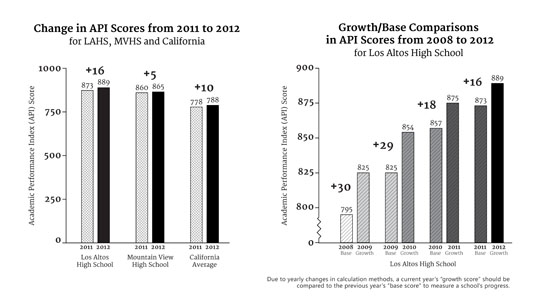
For the fourth year in a row, the school has increased its Academic Performance Index (API) by double digits. Relative to the 2011 base API, the 2012 growth API has increased by 16 points, so that the school’s API, at 889, is now only 11 points from the 900 mark.
“Students should feel proud,” Assistant Principal Perla Pasallo said. “It’s great, it’s a lot of hard work.”
The subgroups whose API raised the most were English Learners, who increased by 69 points and Hispanic students who increased by 28.
“The last couple of years, I think we’ve really had specific teachers focus in on these students and I do believe that all staff members are trying, but to have specific teachers really put in the extra effort has shown the results, whether it’s Homework Club, skill teams or AVID, has really made in the difference,” counselor Jacob Larin said.
To reach this point, the school’s staff did not solely focus on improving CST and CAHSEE scores, the components of the API, but instead focused on developing the school as a whole and found the API improving as a result.
“Continuing our work on the alignment of curriculum, instructional practices and assessment has allowed greater collaboration among teachers and has enriched the learning environment at Los Altos High School,” Principal Wynne Satterwhite said.
The Western Association of School and Colleges (WASC) self-evaluation helped the administration in assessing the school’s situation and finding aspects that could be further improved.
“You really have to take a microscope and look at the school and say these are the areas we need to work on and then ask everybody else,” Pasallo said. “All the stakeholders get asked, students, parents and then we proceed from there based on their feedback.”
After receiving feedback, the school then forms an action plan, consisting of tasks and goals. One of these goals included instituting classes such as World Literature Skills and improving support classes to ensure students are given an equal opportunity to succeed.
“All the support classes that we have — all the skill classes, after-school programs … those are the things that we’ve instituted,” Pasallo said.
Satterwhite said that the teachers’ ability to work together to implement goals and improve student learning in the same course is one of the main factors that has allowed the API to increase.
“As a staff we continue to have conversation and share best practices which lead to agreements, common experiences and higher expectations for all students taking the same class,” Satterwhite said. “Teachers are the answer. It is what they do in the classroom every day that makes a difference for our students … They are committed to creating the best learning environment for all students.”
To continue this improvement in the future and reach the 900 mark, the administration plans to maintain a similar WASC plan, as it has proved to be successful in the past.
“Clearly it’s working and every year we get better at it, and we keep tweaking and making adjustments to it,” Pasallo said. “When we see that something works we jump on it, and when we see that something’s not quite moving ahead, maybe we want to do something a little differently.”
The school is not copying what has been done in years past, but is continuing to find what aspects of the school need further improvement and making advances in those areas.
“It’s not the same thing over and over, it’s continually changing and evolving based on our scores and grades,” Pasallo said. “We don’t do at one end, we do it across all students. It doesn’t matter who you are we want to make you want to succeed even more.”
One of these “adjustments” is ensuring students are giving their all on the tiring three days of STAR testing, as many students do not see the relation between API and the college admission process.
“A few years ago, there was a group of juniors who were asking why the CST were important and we pointed out that when you compared transcripts, grades and courses with students in other schools, those students were getting into different schools,” Satterwhite said.
With the momentum of 93 points of improvement in the past 4 years and by continuing to make tweaks and adjustments, the school has a positive outlook on its staff and students to reach this 900 mark.
“Statistically a school shouldn’t able to move that much [double digits over the past three years], but we have been able to, which says a great deal about our staff and students,” Satterwhite said.








